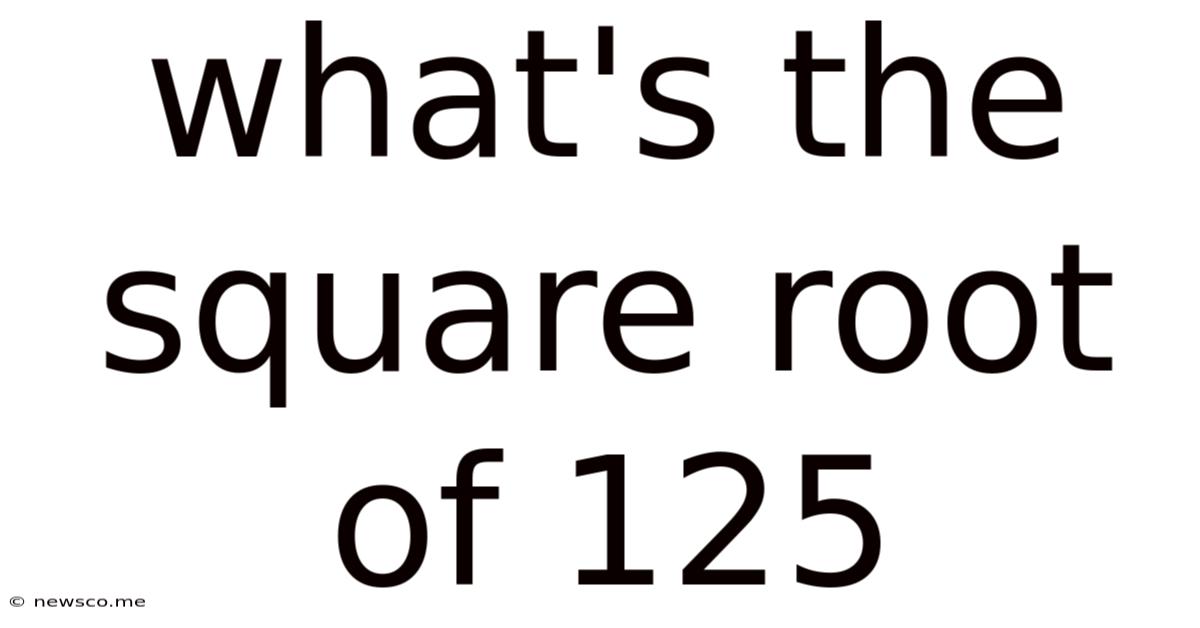What's The Square Root Of 125
News Co
Mar 18, 2025 · 5 min read

Table of Contents
What's the Square Root of 125? A Deep Dive into Square Roots and Simplification
Finding the square root of a number might seem like a simple mathematical operation, but understanding the process and its nuances can open doors to a deeper appreciation of mathematics. This article delves into the question: What's the square root of 125? We'll explore not just the answer, but the underlying concepts, methods of calculation, and applications of square roots. We'll also cover simplifying radicals, an essential skill for anyone working with square roots.
Understanding Square Roots
Before we tackle the square root of 125, let's refresh our understanding of what a square root actually is. The square root of a number is a value that, when multiplied by itself, equals the original number. For example, the square root of 9 is 3 because 3 x 3 = 9. This is often represented mathematically as √9 = 3.
The concept of square roots is fundamentally linked to the concept of squaring a number. Squaring a number means multiplying it by itself. So, if we square 5 (5²), we get 25. The inverse operation is finding the square root; the square root of 25 (√25) is 5.
Calculating the Square Root of 125
Now, let's address the main question: What is the square root of 125 (√125)? Unlike perfect squares like 9 or 25, 125 doesn't have a whole number square root. This means the answer will be an irrational number, a number that cannot be expressed as a simple fraction. We can, however, simplify it.
The key to simplifying square roots lies in finding perfect square factors. We need to find the largest perfect square that divides evenly into 125. Let's break down 125 into its prime factors:
125 = 5 x 25 = 5 x 5 x 5 = 5³
Notice that 25 is a perfect square (5 x 5). We can rewrite √125 as:
√125 = √(25 x 5)
Using the property of square roots that √(a x b) = √a x √b, we can simplify further:
√125 = √25 x √5 = 5√5
Therefore, the simplified square root of 125 is 5√5. This is the exact answer. If you need a decimal approximation, you can use a calculator to find the approximate value of √5 (approximately 2.236) and then multiply by 5 to get approximately 11.18.
Simplifying Radicals: A Step-by-Step Guide
Simplifying radicals, like the one we did with √125, is a crucial skill in algebra and beyond. Here's a step-by-step guide to help you simplify any radical expression:
-
Prime Factorization: Break down the number under the radical sign (the radicand) into its prime factors. This involves repeatedly dividing by prime numbers until you're left with only prime numbers.
-
Identify Perfect Squares: Look for pairs of identical prime factors. Each pair represents a perfect square.
-
Extract Perfect Squares: For each pair of identical prime factors, take one factor out from under the radical sign.
-
Simplify: Multiply the factors outside the radical sign together and leave the remaining factors under the radical sign.
Let's illustrate this with another example: Simplify √72.
-
Prime Factorization: 72 = 2 x 36 = 2 x 2 x 18 = 2 x 2 x 2 x 9 = 2 x 2 x 2 x 3 x 3
-
Identify Perfect Squares: We have a pair of 2s and a pair of 3s.
-
Extract Perfect Squares: We take one 2 and one 3 out from under the radical.
-
Simplify: √72 = 2 x 3 x √(2) = 6√2
Therefore, the simplified form of √72 is 6√2.
Applications of Square Roots
Square roots are not just abstract mathematical concepts; they have numerous practical applications across various fields:
-
Geometry: Calculating the diagonal of a square or rectangle using the Pythagorean theorem (a² + b² = c²) requires finding square roots. The Pythagorean theorem is fundamental in surveying, construction, and many other areas.
-
Physics: Square roots are used extensively in physics, for instance, in calculations involving velocity, acceleration, and energy. Many physical formulas incorporate square roots.
-
Engineering: Engineers use square roots in structural calculations, circuit analysis, and many other engineering disciplines.
-
Finance: Square roots are used in financial modeling and calculations, especially those involving standard deviation and variance in investment analysis.
-
Computer Graphics: Square roots are crucial in computer graphics for calculations related to 3D transformations, rotations, and distances.
Approximating Square Roots
While simplifying radicals provides the exact answer, sometimes a decimal approximation is needed. There are several ways to approximate square roots:
-
Calculator: The simplest method is using a calculator.
-
Babylonian Method: This iterative method allows for increasingly accurate approximations.
-
Linear Approximation: This method uses the tangent line to approximate the square root.
Conclusion: Mastering Square Roots
Understanding square roots, including simplifying radicals, is a fundamental mathematical skill with wide-ranging applications. The seemingly simple question, "What's the square root of 125?" opens the door to a deeper understanding of number theory, algebraic manipulation, and the practical uses of mathematics in various fields. By mastering the techniques of simplifying radicals and approximating square roots, you equip yourself with powerful tools for tackling more complex mathematical problems and real-world applications. Remember, the simplified form of √125 is 5√5, a concise and accurate representation of this irrational number. This exploration of √125 serves as a stepping stone to a more profound understanding of the broader world of mathematics.
Latest Posts
Related Post
Thank you for visiting our website which covers about What's The Square Root Of 125 . We hope the information provided has been useful to you. Feel free to contact us if you have any questions or need further assistance. See you next time and don't miss to bookmark.